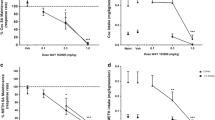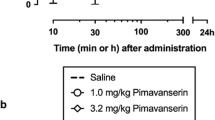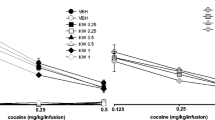Abstract
Rationale
5-Hydroxytryptamine (5-HT) transport inhibitors can attenuate the abuse-related effects of cocaine, and the mechanisms underlying this attenuation may involve activation of 5-HT2C receptors.
Objectives
The objective of this study was to investigate the consequences of direct and indirect pharmacological activation of 5-HT2C receptors on reinstatement of cocaine-seeking behavior induced by cocaine priming and a cocaine-paired stimulus.
Methods
Monkeys were trained to self-administer cocaine under a second-order schedule in which responding was maintained by i.v. cocaine injections and a cocaine-paired stimulus. Drug seeking was extinguished by replacing cocaine with vehicle and eliminating the cocaine-paired stimulus. During reinstatement tests, the animals received a priming injection of cocaine along with restoration of the cocaine-paired stimulus, but only vehicle was available for self administration.
Results
Pretreatment with either the 5-HT transport inhibitor fluoxetine (5.6 mg/kg) or the 5-HT2C receptor agonist Ro 60–0175 (1 mg/kg) attenuated reinstatement of drug seeking by cocaine priming. The reinstatement-attenuating effects of both drugs were reversed by the 5-HT2C receptor antagonist SB 242084 (0.03–0.56 mg/kg). Ro 60–0175 (1 mg/kg) attenuated cocaine-induced reinstatement of drug seeking regardless of whether priming injections were or were not accompanied by restoration of the cocaine-paired stimulus. Ro 60–0175 (0.56 mg/kg) was equally effective whether it was administered acutely or chronically. Finally, Ro 60–0175 (0.3–1 mg/kg) had observable behavioral effects suggestive of anxiolytic-like properties.
Conclusions
5-HT2C receptor mechanisms play a key role in the modulation of cocaine-induced reinstatement by fluoxetine and Ro 60–0175. Direct activation of 5-HT2C receptors may offer a novel, tolerance-free therapeutic strategy for the prevention of cocaine relapse.





Similar content being viewed by others
References
Barbon A, Orlandi C, La Via L, Caracciolo L, Tardito D, Musazzi L, Mallei A, Gennarelli M, Racagni G, Popoli M, Barlati S (2011) Antidepressant treatments change 5-HT2C receptor mRNA expression in rat prefrontal/frontal cortex and hippocampus. Neuropsychobiology 63:160–168
Birkett MA, Platt DM, Tiefenbacher S, Rowlett JK (2005) A “pharmacological stressor” model of anxiolysis in monkeys: Alprazolam attenuation of the behavioral and physiological effects of yohimbine. Neuropsychopharmacology 30:S235
Brink CB, Viljoen SL, de Kock SE, Stein DJ, Harvey BH (2004) Effects of myo-inositol versus fluoxetine and imipramine pretreatments on serotonin 5HT2A and muscarinic acetylcholine receptors in human neuroblastoma cells. Metab Brain Dis 19:51–70
Bubar MJ, Cunningham KA (2007) Distribution of serotonin 5-HT2C receptors in the ventral tegmental area. Neuroscience 146:286–297
Bubar MJ, Cunningham KA (2008) Prospects for serotonin 5-HTR pharmacotherapy in psychostimulant abuse. Prog Brain Res 172:319–346
Burbassi S, Cervo L (2008) Stimulation of serotonin2C receptors influences cocaine-seeking behavior in response to drug-associated stimuli in rats. Psychopharmacology 196:15–27
Burmeister JJ, Lungren EM, Kirschner KF, Neisewander JL (2004) Differential roles of 5-HT receptor subtypes in cue and cocaine reinstatement of cocaine-seeking behavior in rats. Neuropsychopharmacology 29:660–668
Castles DL, Whiten A, Aureli F (1999) Social anxiety, relationships and self-directed behaviour among wild female olive baboons. Anim Behav 58:1207–1215
Craige CP, Unterwald EM (2013) Serotonin(2C) receptor regulation of cocaine-induced conditioned place preference and locomotor sensitization. Behav Brain Res 238:206–210
Czoty PW, Ginsburg BC, Howell LL (2002) Serotonergic attenuation of the reinforcing and neurochemical effects of cocaine in squirrel monkeys. J Pharmacol Exp Ther 300:831–837
Di Matteo V, Di Giovanni G, Di Mascio M, Esposito E (1999) SB 242084, a selective serotonin2C receptor antagonist, increases dopaminergic transmission in the mesolimbic system. Neuropharmacology 38:1195–1205
Diaz SL, Doly S, Narboux-Neme N, Fernandez S, Mazot P, Banas SM, Boutourlinsky K, Moutkine I, Belmer A, Roumier A, Maroteaux L (2012) 5-HT2B receptors are required for serotonin-selective antidepressant actions. Mol Psychiatry 17:154–163
Filip M, Bubar MJ, Cunningham KA (2004) Contribution of serotonin (5-hydroxytryptamine; 5-HT) 5-HT2 receptor subtypes to the hyperlocomotor effects of cocaine: Acute and chronic pharmacological analyses. J Pharmacol Exp Ther 310:1246–1254
Fletcher PJ, Grottick AJ, Higgins GA (2002) Differential effects of the 5-HT2A receptor antagonist M100,907 and the 5-HT2C receptor antagonist SB242,084 on cocaine-induced locomotor activity, cocaine self-administration and cocaine-induced reinstatement of responding. Neuropsychopharmacology 27:576–586
Fletcher PJ, Chintoh AF, Sinyard J, Higgins GA (2004) Injection of the 5-HT2C receptor agonist Ro60-0175 into the ventral tegmental area reduces cocaine-induced locomotor activity and cocaine self-administration. Neuropsychopharmacology 29:308–318
Fletcher PJ, Rizos Z, Sinyard J, Tampakeras M, Higgins GA (2008) The 5-HT2C receptor agonist Ro60-0175 reduces cocaine self-administration and reinstatement induced by the stressor yohimbine, and contextual cues. Neuropsychopharmacology 33:1402–1412
Fone KC, Austin RH, Topham IA, Kennett GA, Puhani T (1998) Effect of chronic m-CPP on locomotion, hypophagia, plasma corticosterone and 5-HT2C receptor levels in the rat. Br J Pharmacol 123:1707–1715
Frankel PS, Cunningham KA (2004) m-Chlorophenylpiperazine (mCPP) modulates the discriminative stimulus effects of cocaine through actions at the 5-HT2C receptor. Behav Neurosci 118:157–162
Grottic AJ, Fletcher PJ, Higgins GA (2000) Studies to investigate the role of 5-HT2C receptors on cocaine- and food-maintained behaviors. J Pharmacol Exp Ther 295:1183–1191
Howell LL, Byrd LD (1995) Serotonergic modulation of the behavioral effects of cocaine in the squirrel monkey. J Pharmacol Exp Ther 275:1551–1559
Khroyan TV, Barrett-Larimore RL, Rowlett JK, Spealman RD (2000) Dopamine D1- and D2-like receptor mechanisms in relapse to cocaine-seeking behavior: Effects of selective antagonists and agonists. J Pharmacol Exp Ther 294:680–687
Li Q, Sullivan NR, McAllister CE, Van de Kar LD, Muma NA (2012) Estradiol accelerates the effects of fluoxetine on serotonin 1A receptor signaling. Psychoneuroendocrinology. doi:10.1016/j.psyneuen.2012.11.005
Lopez-Gimenez JF, Mengod G, Palacios JM, Vilaro MT (2001) Regional distribution and cellular localization of 5-HT2C receptor mRNA in monkey brain: comparison with [3H]mesulergine binding sites and choline acetyltransferase mRNA. Synapse 42:12–26
Manvich DF, Kimmel HL, Howell LL (2012a) Effects of serotonin 2C receptor agonists on the behavioral and neurochemical effects of cocaine in monkeys. J Pharmacol Exp Ther 341:424–434
Manvich DF, Kimmel HL, Cooper DA, Howell LL (2012b) The serotonin 2C receptor antagonist SB 242084 exhibits abuse-related effects typical of stimulants in squirrel monkeys. J Pharmacol Exp Ther 342:761–769
Martin JR, Bös M, Jenck F, Moreau J-L, Mutel V, Sleight AJ, Wichmann J, Andrews JS, Berendsen HHG, Broekkamp CLE, Ruigt GSF, Köhler C, van Delft AML (1998) 5-HT2C receptor agonists: Pharmacological characteristics and therapeutic potential. J Pharmacol Exp Ther 286:913–924
Mongeau R, Martin CBP, Chevarin C, Maldonado R, Hamon M, Robledo P, Lanfumey L (2010) 5-HT2C receptor activation prevents stress-induced enhancement of brain 5-HT turnover and extracellular levels in the mouse brain: modulation by chronic paroxetine treatment. J Neurochem 115:438–449
Navailles S, Moison D, Cunningham KA, Spampinato U (2008) Differential regulation of the mesoaccumbens dopamine circuit by serotonin 2C receptors in the ventral tegmental area and the nucleus accumbens: an in vivo microdialysis study with cocaine. Neuropsychopharmacology 33:237–246
Neisewander JL, Acosta JI (2007) Stimulation of 5-HT2C receptors attenuates cue and cocaine-primed reinstatement of cocaine-seeking behavior in rats. Behav Pharmacol 18:791–800
Nic Dhonnchadha BA, Bourin M, Hascoet M (2003) Anxiolytic-like effects of 5-HT2 ligands on three mouse models of anxiety. Behav Brain Res 140:203–214
Platt DM, Rowlett JK, Spealman RD (2000) Dissociation of cocaine-antagonist properties and motoric effects of the D1 receptor partial agonists SKF 83959 and SKF 77434. J Pharmacol Exp Ther 293:1017–1026
Platt DM, Carey GJ, Spealman RD (2012) Models of neurological disease (substance abuse): Self-administration in monkeys. In: Enna S, Williams M (eds) Current protocols in pharmacology. Wiley, New York, pp 10.5.1–10.5.17
Pozzi L, Acconcia S, Ceglia I, Invernizzi RW, Samanin R (2002) Stimulation of 5-hydroxytryptamine (5-HT2C) receptors in the ventrotegmental area inhibits stress-induced but not basal dopamine release in the rat prefrontal cortex. J Neurochem 82:93–100
Rüedi-Bettschen D, Rowlett JK, Spealman RD, Platt DM (2010) Attenuation of cocaine-induced reinstatement of drug seeking in squirrel monkeys: Kappa opioid and serotonergic mechanisms. Psychopharmacology 210:169–177
Sawyer EK, Mun J, Nye JA, Kimmel HL, Voll RJ, Stehouwer JS, Rice KC, Goodman MM, Howell LL (2012) Neurobiological changes mediating the effects of chronic fluoxetine on cocaine use. Neuropsychopharmacology 37:1816–1824
Schino G, Perretta G, Taglioni AM, Monaco V, Troisi A (1996) Primate displacement activities as an ethopharmacological model of anxiety. Anxiety 2:186–191
Spealman RD (1993) Modification of behavioral effects of cocaine by selective serotonin and dopamine uptake inhibitors in squirrel monkeys. Psychopharmacology 112:93–99
Spealman RD, Barrett-Larimore RL, Rowlett JK, Platt DM, Khroyan TV (1999) Pharmacological and environmental determinants of relapse to cocaine-seeking behavior. Pharmacol Biochem Behav 64:327–336
Spealman RD, Lee B, Tiefenbacher S, Platt DM, Rowlett JK, Khroyan TV (2004) Triggers of relapse: Nonhuman primate models of reinstated drug seeking. In: Bevins R, Bardo MT (eds) Motivational factors in the etiology of drug abuse. University of Nebraska Press, Lincoln, pp 57–84
Troisi A (2002) Displacement activities as a behavioral measure of stress in nonhuman primates and human subjects. Stress 5:47–54
Acknowledgments
We thank K. Bano, L. Teixeira, and R. Smith for technical assistance.
Author information
Authors and Affiliations
Corresponding author
Additional information
This research was supported by DA11054, RR00168, and OD11103.
Rights and permissions
About this article
Cite this article
Rüedi-Bettschen, D., Spealman, R.D. & Platt, D.M. Attenuation of cocaine-induced reinstatement of drug seeking in squirrel monkeys by direct and indirect activation of 5-HT2C receptors. Psychopharmacology 232, 2959–2968 (2015). https://doi.org/10.1007/s00213-015-3932-z
Received:
Accepted:
Published:
Issue Date:
DOI: https://doi.org/10.1007/s00213-015-3932-z




